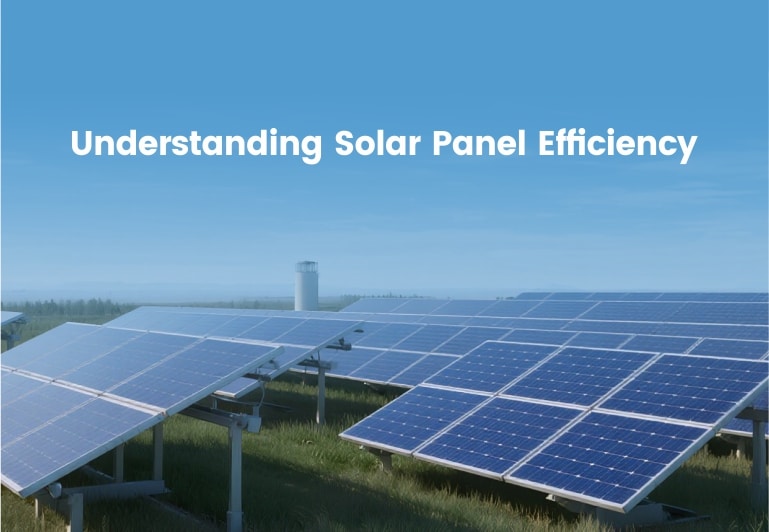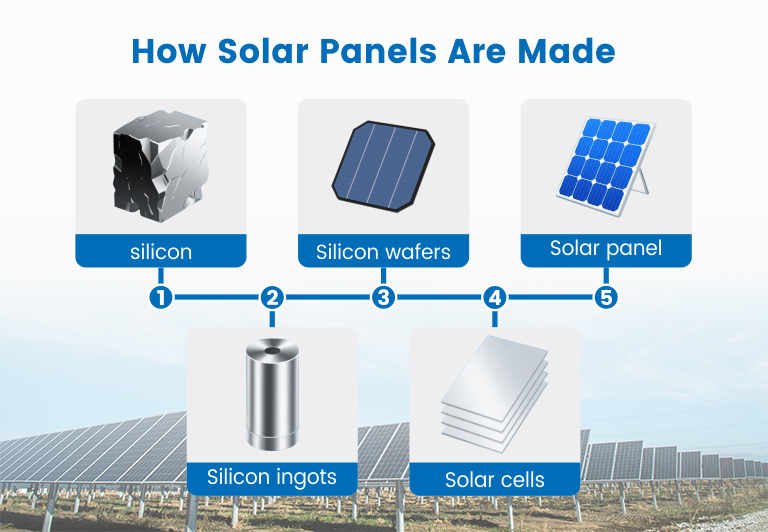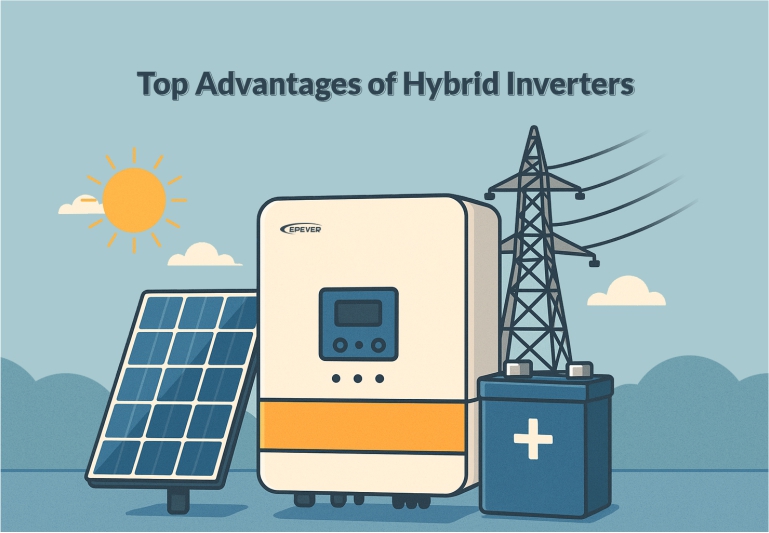Understanding Solar Panel Efficiency
- 29 July 2025
- 94 views
- No Comments
Understanding Solar Panel Efficiency
Solar panels are marvels of modern engineering, designed to transform sunlight into usable electricity through the photovoltaic effect. Despite their utility, they are not perfect energy converters. A common and essential question for anyone exploring solar energy is: how efficient are solar panels? This question isn’t merely academic—it directly affects how much energy a solar system can deliver, how much surface area it will require, and how well it aligns with energy needs.
What Is Solar Panel Efficiency?
Efficiency in solar panels refers to the ratio of sunlight (irradiance) that a panel can convert into electrical energy. This figure is expressed as a percentage. For example, if a panel receives 1000 watts per square meter of sunlight and converts 200 watts into electricity, it has an efficiency of 20%.
Currently, the vast majority of commercial solar panels operate in the 15–20% efficiency range. This is largely due to the intrinsic limits of the photovoltaic materials used—primarily silicon. These materials function by absorbing photons from sunlight, which in turn excites electrons in the panel’s semiconductor layers. The movement of these electrons across a p-n junction creates an electric current.

However, several physical and environmental factors inherently limit how much sunlight can be converted into electricity. These include:
Heat Loss: Not all absorbed solar energy contributes to electricity—some becomes heat, which can actually reduce performance.

Environmental Conditions: Factors like soiling (dust), shading, and cloud cover can affect panel output in the real world.

How Do Solar Panels Work?
Understanding how solar panels work is key to grasping their efficiency, application, and limitations. At the core of every solar panel is a system of photovoltaic (PV) cells, most commonly made from crystalline silicon. These cells are designed to capture sunlight and convert it into electricity via the photovoltaic effect—a phenomenon first observed in the 19th century and now the backbone of modern solar energy systems.
The Step-by-Step Photovoltaic Process
1. Photon Absorption
Sunlight is composed of tiny particles called photons. When these photons strike the surface of a solar cell, their energy is absorbed by the semiconductor material (typically silicon). This energy excites electrons within the material.
2. Excitation
Absorbed photon energy causes electrons in the silicon atoms to become energized enough to break free from their atomic bonds. These freed electrons are now mobile and can conduct electricity.
3. Electric Field Generation (p-n Junction)
Each PV cell contains a p-n junction, which is the interface between p-type (positive) and n-type (negative) semiconductors. This junction creates a built-in electric field that pushes the free electrons in one direction—toward the electrical contacts—creating a flow of charge.
4. Electron Flow and Direct Current (DC) Generation
Freed electrons are directed into an external circuit, forming an electric current. This current is direct current (DC)—meaning the electrons flow in one consistent direction. This flow is harnessed to power electronic devices or stored in batteries.
Note-Closed-Loop Clarification: The current forms a closed-loop circuit, electrons do not get consumed or depleted. Instead, they are energized by photons, routed through the load (e.g., household appliances), and return to the solar cell. The sun keeps energizing the same pool of electrons, allowing for continuous electricity generation.
5. Conversion to Alternating Current (AC)
Most homes and grids use alternating current (AC), so the DC produced by solar panels must be converted. This is done using an inverter, which changes the unidirectional flow of electrons into a back-and-forth (alternating) flow suitable for conventional appliances.
Continuous and Instantaneous Operation
This entire photovoltaic process is instantaneous and continuous—as long as sunlight reaches the panel. There are no moving parts. The system relies entirely on the interaction between light and solid-state semiconductor materials.
Key Influences on Performance
The efficiency of this process depends on multiple factors:
- Material Quality: Higher-grade silicon and fewer crystal defects improve performance.
- Temperature: High heat can reduce voltage output, thereby lowering efficiency.
- Irradiance and Light Spectrum: Direct sunlight produces higher output than diffuse or shaded light.
- Soiling and Maintenance: Dust or dirt can reduce the amount of light reaching the cells, cutting output.
Types of Solar Panels and Their Relative Efficiencies
Solar panels are not uniform in their performance. They typically fall into three broad categories, each with distinct characteristics:
- Monocrystalline Panels
- Efficiency: 15% – 20% and beyond
- Structure: Made from a single continuous crystal structure of silicon
- Performance: Highest efficiency and power output per square meter
- Appearance: Recognizable by their rounded cell edges
- Best Use: Rooftops with limited space or high energy demands
- Polycrystalline Panels
- Efficiency: 13% – 16%
- Structure: Composed of multiple silicon crystal fragments melted together
- Performance: Lower than monocrystalline but more accessible
- Best Use: Medium-scale installations with moderate space constraints
- Thin-Film Panels
- Efficiency: 7% – 13%
- Structure: Use layers of photovoltaic material on a substrate like glass or metal
- Performance: Lightweight, flexible, and easiest to produce
- Best Use: Utility-scale projects or surfaces unsuitable for rigid panels
Each panel type represents a tradeoff between performance, material complexity, and space requirements. For example, while thin-film panels may be less efficient, their low weight and flexibility make them ideal in specialized applications.
Factors That Influence Real-World Solar Panel Efficiency
While lab-tested efficiency ratings offer useful benchmarks, real-world conditions introduce many variables that affect how well solar panels perform once installed:
- Temperature: Contrary to intuition, solar panels are less efficient in high temperatures. Excessive heat reduces voltage output and can slightly degrade energy production.
- Material Purity: Higher-quality silicon and fewer crystal defects result in more efficient electron movement, improving energy yield.
- Irradiance (Sunlight Intensity): Solar panels operate best under direct sunlight. While they still work on cloudy days, lower irradiance levels mean reduced output.
- Angle and Orientation: Solar panels must be positioned to optimize exposure to the sun’s path. Even slight shading or improper tilt can substantially reduce output.
- Soiling and Debris: Dust, leaves, bird droppings, and pollution can block light from reaching the cells, reducing efficiency.
Looking Ahead: Solar Efficiency and Next-Generation Technologies
Solar panel efficiency—the proportion of sunlight converted into usable electricity—is not a static number. While mature silicon-based panels commonly reach 22–23% efficiency under controlled test conditions, ongoing advancements continue to push the boundaries of what’s possible. Rather than anchoring to short-term figures, it’s more insightful to look at the underlying innovations that define the direction of photovoltaic technology.
Beyond Silicon: New Materials and Architectures
Perovskite Solar Cells
Perovskites have emerged as one of the most promising materials in solar research. These compounds can be manufactured at low temperatures, are lightweight, and demonstrate high absorption efficiency. Although their long-term durability remains under refinement, their rapid progress suggests they will play a significant role in future panel designs—either standalone or as part of hybrid structures.
Tandem (Multi-Junction) Architectures
Instead of relying on a single light-absorbing layer, tandem cells combine multiple materials to capture different portions of the solar spectrum. A common design involves layering a perovskite cell on top of a silicon base. This approach theoretically enables conversion efficiencies well above 30%, offering a clear route for breaking the long-standing efficiency ceiling of conventional silicon cells.
Bifacial Module Design
Bifacial panels are engineered to absorb sunlight from both their front and rear surfaces. When installed in reflective environments—such as rooftops, deserts, or snowy regions—this dual exposure can provide significant gains in total energy yield, often between 5–15% over monofacial equivalents. As installation practices evolve, bifaciality is becoming an increasingly valuable feature in both commercial and utility-scale deployments.
Contextualizing Efficiency in Real-World Systems
While lab efficiencies and emerging materials paint an exciting picture, practical performance always depends on broader system dynamics:
- Typical Operational Range: Most commercial systems today still function in the 15–20% efficiency range.
- Installation Factors: Panel tilt, shading, orientation, and ambient temperature have measurable impacts.
- System Integration: Inverters, wiring, and load matching affect overall power delivery.
- Maintenance: Dust, soiling, and degradation can reduce panel output over time.
Forward-Looking
The direction of solar innovation is clear: higher efficiencies, lower costs, more adaptable formats. Whether through the integration of new materials like perovskites, the optimization of multi-junction cell stacking, or enhanced system designs like bifacial configurations, the next generation of solar technology will likely offer not only greater performance but also better integration into diverse environments.
Instead of asking, “What is the efficiency today?”—a better question for long-term relevance is, “What technologies are shaping the next leap in solar performance?”




